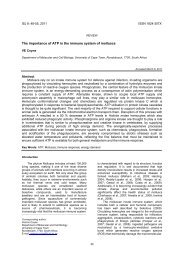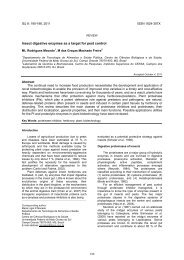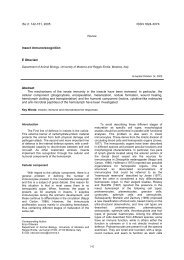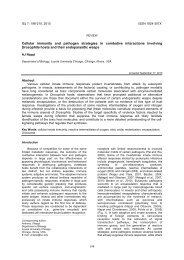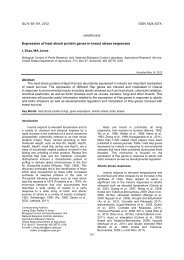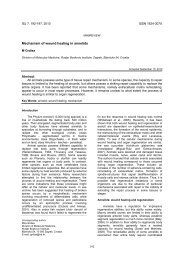Parasite-host relationship: a lesson from a professional killer
Parasite-host relationship: a lesson from a professional killer
Parasite-host relationship: a lesson from a professional killer
You also want an ePaper? Increase the reach of your titles
YUMPU automatically turns print PDFs into web optimized ePapers that Google loves.
Fig. 11 A scheme delineating some parasite immunoevasion/depression processes related to hemolymph PRRs<br />
removal.<br />
ascertain the interference of the parasite with the<br />
inducible antibacterial response of G. mellonella; this<br />
topic is particularly relevant in the studied model since<br />
these parasites, besides escaping <strong>host</strong> immune<br />
defenses, seem to be able to down-regulate AMPs<br />
genes reducing the synthesis of molecules potentially<br />
harmful for their symbiontic bacteria (manuscript in<br />
preparation).<br />
Concluding remarks<br />
Our society increasingly demands alternatives to<br />
chemicals for managing insect pests and insect<br />
vectors of diseases; even though biological control by<br />
means of bioinsecticides holds great promises, no<br />
more than 1.5 % of commercial pesticides are<br />
represented by biologicals. Researches directed<br />
towards a better knowledge of nematocomplexesinsects<br />
<strong>relationship</strong>s could provide a valuable starting<br />
point for the improvement of integrated pest<br />
management techniques, with the aim of drastically<br />
reducing the use of chemicals.<br />
Moreover, <strong>from</strong> studies of model insects immune<br />
system is clearly emerging a fascinating picture of the<br />
evolution of immune responses common to both<br />
invertebrates and vertebrates.<br />
Acknowledgments<br />
We are grateful to Magda de Eguileor for TEM<br />
micrograph, to Michela Curradi for the critical reading<br />
of the manuscript and to Alberto Vianelli for language<br />
checking and suggestions.<br />
References<br />
Agaisse H, Petersen UM, Boutros M, Mathey-Prevot B,<br />
Perrimon N. Signaling role of hemocytes in Drosophila<br />
JAK/STAT-dependent response to septic injury. Dev.<br />
Cell 5: 441-50, 2003.<br />
51<br />
Akhurst, RJ, Dunphy GB. Tripartite interactions between<br />
symbiotically associated entomopathogenic bacteria,<br />
nematodes, and their insect <strong>host</strong>s. In: Beckage NE,<br />
Thompson SN, Federici BA. (eds) <strong>Parasite</strong>s and<br />
pathogens of insects, Vol. 2: pathogens, Academic<br />
Press, New York, NY, pp. 1-23, 1993.<br />
Asgari S, Zhang G, Zareie R, Schmidt O. A serine proteinase<br />
homolog venom protein <strong>from</strong> an endoparasitoid wasp<br />
inhibits melanization of the <strong>host</strong> hemolymph. Insect<br />
Biochem. Mol. Biol. 33: 1017-24, 2003.<br />
Ashida M. The prophenoloxidase cascade in insect immunity.<br />
Res. Immunol. 90: 908-910, 1990.<br />
Bayne CJ, Boswell CA, Yui MA. Widespread antigenic crossreactivity<br />
between plasma proteins of a gastropod and<br />
its trematode parasite. Dev. Comp. Immunol. 11: 321-<br />
329, 1987.<br />
Beetz S, Brinkmann M, Trenczek T. Differences between<br />
larval and pupal hemocytes of the tobacco hornworm,<br />
Manduca sexta, determined by monoclonal antibodies<br />
and density centrifugation. J. Insect Physiol. 50: 805-<br />
819, 2004.<br />
Blaxter ML, Page AP, Rudin W, Maizels RM. Nematode<br />
surface coats: actively evading immunity. Parasitol.<br />
Today 8: 243–47, 1992.<br />
Brehelin M, Zachary D. Immunity in Invertebrates, Springer<br />
Verlag, Berlin, 1986.<br />
Brivio MF, Mastore M, Moro M. The role of Steinernema<br />
feltiae body-surface lipids in <strong>host</strong>–parasite<br />
immunological interactions. Molec. Biochem.<br />
Parasitol.135: 111-121, 2004.<br />
Brivio MF, Mazzei C, Scarì G. proPO System of Allogamus<br />
auricollis (Insecta): effects of Various Compounds on<br />
Phenoloxidase Activity. Comp. Biochem. Physiol. 113B:<br />
281-287, 1996.<br />
Brivio MF, Pagani M, Restelli S. Immune suppression of<br />
Galleria mellonella (Insecta, Lepidoptera) humoral<br />
defenses induced by Steinernema feltiae (Nematoda,<br />
Rhabditida): involvement of the parasite cuticle. Exp.<br />
Parasitol. 101: 149-156, 2002.<br />
Bulet P, Hetru C, Dimarcq JL, Hoffmann D. Antimicrobial<br />
peptides in insects; structure and function. Dev. Comp.<br />
Immunol. 23: 329-44, 1999.<br />
Caldas C, Cherqui A, Pereira A, Simoes N. Purification and<br />
characterization of an extracellular protease <strong>from</strong><br />
Xenorhabdus nematophila involved in insect<br />
immunosuppression. Appl. Env. Microbiol. 68: 1297-<br />
1304, 2002.



